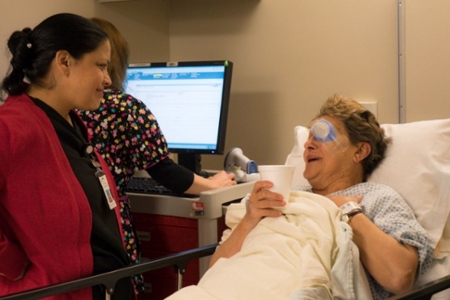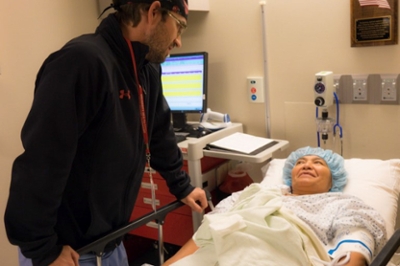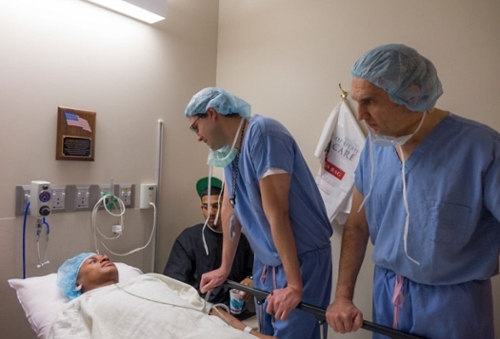Breadcrumb
And Grows to Include More Patients, More Staff
Thanks to the combined efforts of volunteer doctors, nurses, technicians, anesthesiologists, and staff, 27 individuals had cataracts removed and their sight restored on Saturday, March 28, 2015, as part of the Moran Outreach Division’s bi-annual Charity Surgery Day. For the first time, The Eye Institute of Utah participated in the event as well, treating 14 of the 27.
For many people, independence and financial stability are dependent on good health. Blindness in particular can lead to unemployment and homelessness. While cataract surgery is one of the safest and most commonly performed operations around the world, many cataract sufferers are forced to put their lives and livelihoods on hold because they cannot afford treatment. Often, they must rely on others for everyday functioning and care. In turn, many suffer from depression and low self-esteem. Most cataract patients in this population are too young for Medicare, work at low wages, or are under- or uninsured. This condition plays a major role in unemployment and even homelessness.
A cataract is a clouding of the lens of the eye; it prevents light rays from passing through the lens and focusing on the retina. A white cataract is generally more mature, denser, and harder than a regular cataract, and may have been caused by trauma to the eye. While not the norm in the US, white cataracts require that physicians use more advanced, complex techniques than they would for routine cataract surgery.
Fredi Martinez, Alba Hernandez, and Mirta Brancolino are three Charity Surgery Day patients whose lives have been impacted by cataracts.

MIRTA, 74, originally from Santa Fe, Argentina, has cataracts in both eyes. She lives by herself, loves to cook for her family, care for her four grandchildren, and read. She is described as "a very active, upbeat person and does not to let her vision loss stop her from doing anything" despite the fact that "faces are blurry" to her and she must "lean in close when she cooks or make the letters on her iPad big to read," says her daughter-in law Sandra Bonaldo. Tears well up in Mirta’s eyes when she describes through interpreter Patricia Alcazar-Sanchez, COMT that it is being with her family that makes her heart sing. After the cataract is removed from her left eye, Mirta is all smiles: "Moran is extraordinary; I am so happy, Muy, muy, bien."

ALBA, 54, has fished and worked in California fruit and vegetable fields for a good part of her adult life, picking garlic, grapes, oranges, artichokes, and more. But when she developed cataracts in both eyes, Alba could not see if the fruit and vegetables were ripe to pick; she could only hope to tell by touch, which slowed her down and eventually forced her to lose her job. She would bump into benches and signs, and it was very difficult for her to cook. But Alba is very happy; she knows there is hope. She had a cataract removed in her left eye six months ago, and has since gotten a job packaging meat. She says even though her vision is still compromised, her boss is very patient with her because he knows she is having another surgery. "I am just very happy to be able to work again," she says through interpreter Pamela Velasquez, PFA. "There are so many very excellent people here who have given me back my life—hope."

FREDI, 26, loves to play with his two young boys when he gets home from work as a chef in a contemporary American restaurant in Salt Lake City. Although Fredi is highly functioning, he has a white cataract in his right eye. When Fredi was eight-years-old, he was thrown from a donkey into thorn bushes, and one of the thorns stuck in his eye. Doctors in Oaxaca, Mexico, thought if they pulled the thorn out, Fredi would lose his eye. They pulled it out and actually saved his eye. But the injury eventually caused a hard, dense cataract to develop, which is unusual for someone as young as Fredi. His vision loss makes Fredi dizzy; he gets headaches and bright lights hurt his eye. And at work, he has to look closely at what he is doing. "He is my favorite uncle," says Chris Hernandez, 18, interpreting for Fredi. "He has helped me out a lot, given me a home. He’s a good person. Fredi has been really nervous; he thought he was going to completely loose his sight." The day after surgery, Fredi is very happy, he can see! And he’s glad it is all over with!
Moran’s Outreach Division partners with community healthcare programs throughout the state of Utah to serve those living in need. Initiated in 2012 by Moran residents, Charity Surgery Day is an outgrowth of the volunteer eye care residents provide at Salt Lake City’s Fourth Street Clinic. Today, over 100 people have received sight-restoring surgery through the program, and Charity Surgery Days are still organized by Moran residents.
Charity Surgery Day has proven so successful and cost-efficient, the American Society of Cataract and Refractive Surgery (ASCRS) Foundation’s new "Operation Sight" network adopted Moran as a model in 2014. Moran is one of five founding members of the network, whose mission is to provide a centralized approach for organizations and volunteer surgeons who wish to end cataract blindness in the US.
The event was supported by donors to the Moran Eye Center and by the Night for Sight Fundraiser, as well as the partnership with Operation Sight and ASCRS.